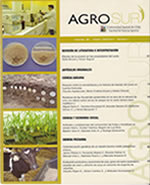Evaluation of erosion and selection of forest species for the rehabilitation of degraded soils of volcanic origin in Ecuador
Main Article Content
Abstract
Human activities not only accelerate soil redistribution rates on hillslopes, but also alter patterns of erosion and deposition. The objectives to cuantify the surface net erosion (Net erosion= Erosion – Sedimentation) and to assess the establishment of forestry species in soil conservation structures. The surface erosion was quantified with erosion pins located at the upper, middle and lower parts of four hillsides with a slope between 35% and 42%. The establishment of forestry species on contour ploughing considered two phases. During phase I, the following species were established on each hillside: Schinus molle, Caesalpinia spinosa, and Vachellia macracantha, while the fourth hillside (control) was not considered for forestry species. Results after four years showed that net erosion was 102 Mg ha-1 in the middle hillside part, a 36% higher than the upper and lower parts. After 27 months, V. macracantha showed a survival of 85%, while in the other species was < 3%. During Phase II the species were replaced by Morynga oleifera and Acacia melanoxyon. After 9 months, the species showed a survival 30% and 10%, respectively, while V. macracantha recorded 58%. Erosion pins can be an inexpensive and a simple technique to quantify net erosion in areas with low coverage and strong slopes. It was concluded that erosion pins are a useful tecnique to quantify erosive processes over the time. V. macracantha showed a higher adaptation to the local conditions and greater tolerance to highly alkaline soils with low fertility.

